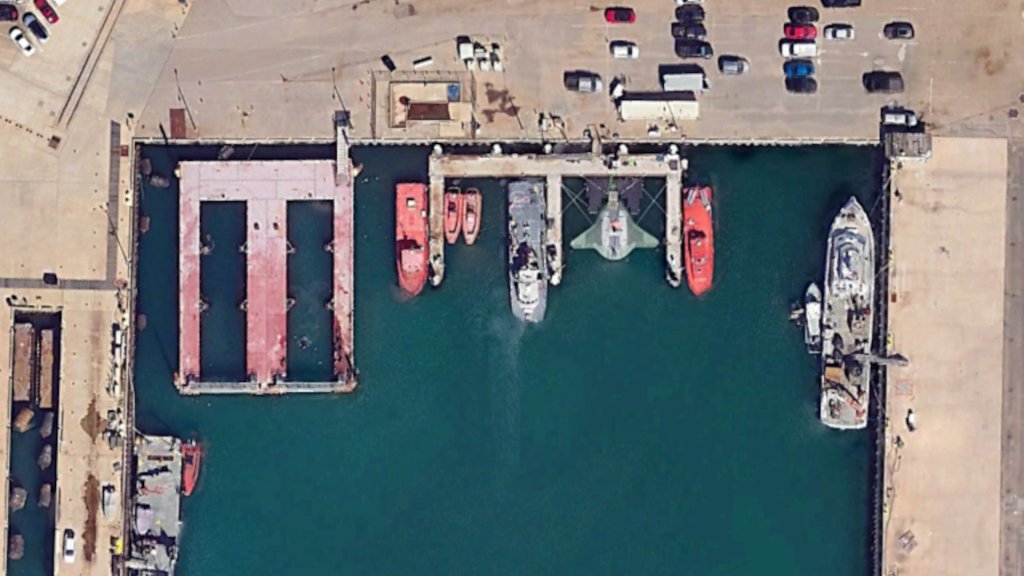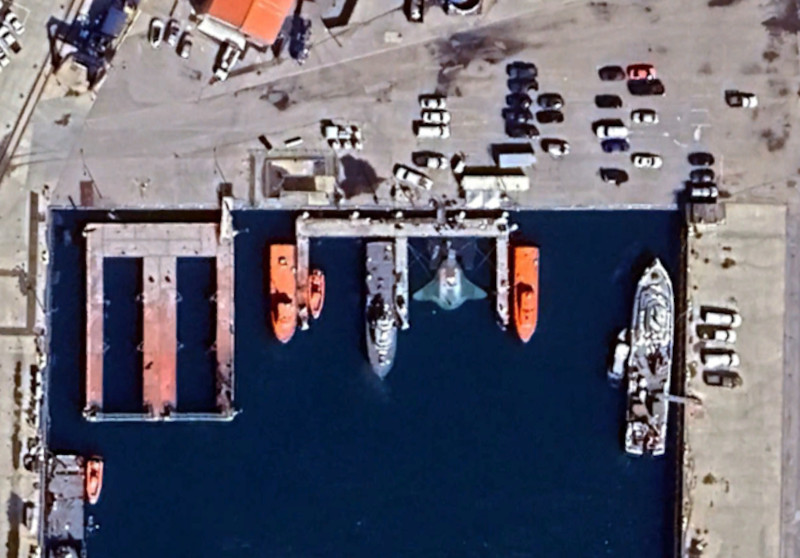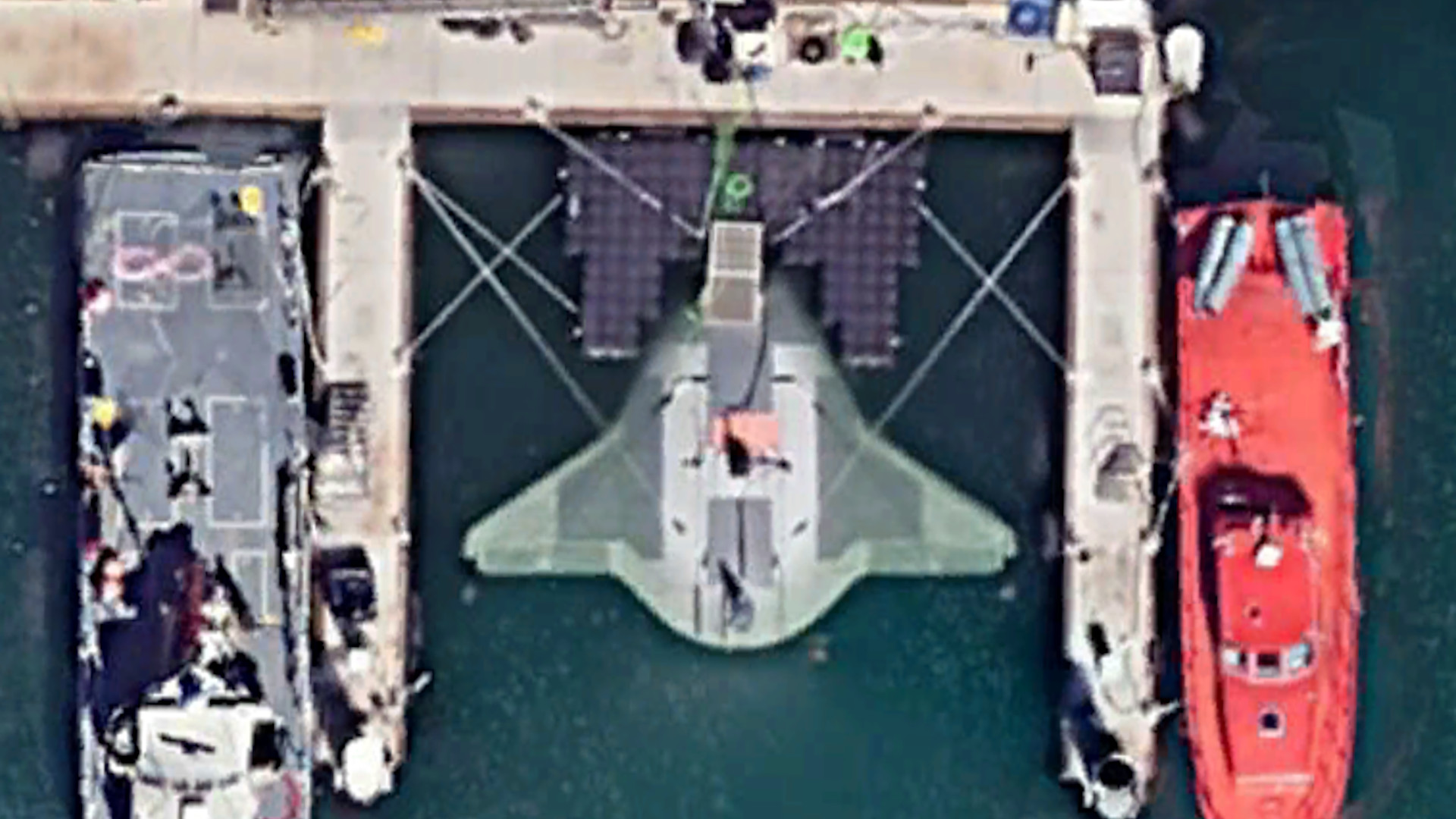We are finally getting a clear idea of just how big Northrop Grumman’s Manta Ray submersible drone is, with satellite images showing it in port looking like something that just landed on Tatooine. Manta Ray is being developed under a Defense Advanced Research Projects Agency (DARPA) program that is focused on demonstrating a new category of very-long-endurance uncrewed naval platform that could be configured to perform a host of different missions. You can read more about what is known about the design, which had already been shown to be much larger than was originally understood, in our past reporting here.
Satellite images taken in November 2023 and April of this year that are now available through Google Earth show the Manta Ray docked at the Port Hueneme naval base in California. Port Hueneme, which is part of the U.S. Navy’s larger Naval Base Ventura County, is home to the Naval Surface Warfare Center-Port Hueneme Division (NSWC PHD) and is a major research and development and test and evaluation hub.

The November 2023 image recently began circulating on social media.
Manta Ray’s ‘wingspan’ is around 45 feet and it has an overall length of 33 feet from what can now be seen in the satellite images. For comparison, Boeing’s Echo Voyager underwater vehicle (UUV), from which the larger and still-in-development Orca design for the U.S. Navy is derived, is 51 feet long, but also is much narrower. The torpedo-like REMUS 600, one of the largest operational UUVs in Navy service currently, is just 10.6 feet long and 12.75 inches in diameter.

To date, neither Northrop Grumman nor DARPA appears to have released any dimensional data or other specifications for the drone. Northrop Grumman did note the potential challenges to operationalizing the design due to its size and highlighted steps it has taken to mitigate those issues in an internal news item it put out earlier this month. Pictures and videos, seen below, the company has previously released show that a crane fitted with a specialized frame is needed to get the Manta Ray in and out of the water. The U.S. Navy notably canceled its Snakehead UUV program last year in large part due to concerns about limited options for actually deploying and recovering it.


“Most large undersea vehicles, like submarines, are so big when fully assembled that they can’t be put on a truck or ship to transport. Our engineers designed Manta Ray with these considerations in mind,” according to Northrop Grumman. “Thanks to its modular design, Manta Ray can be separated into parts for easy shipping. Then, it can be assembled in-field.”
The Manta Ray demonstrator was built at a site in Maryland before being shipped across the country to California.
“With missions around the world, the U.S. military and our allies must be expeditionary,” the company added in its internal news story. “Manta Ray allows them to bring critical capabilities wherever they are needed.”
Northrop Grumman has also touted other features of the Manta Ray demonstrator, which was publicly unveiled in April and is categorized as an “extra-large glider” with a lifting body-like shape. The unique craft, which completed an initial round of in-water testing off the coast of southern California between February and March, is powered, via a pair of propellers on its ‘wing tips.’ More specific details about its propulsion system are scant.

“A glider has a really intriguing propulsion mechanism, falling forward [with purpose] through the water all the time, both upward and downward,” Brian Theobald, principal investigator and chief engineer for Manta Ray at Northrop Grumman, said in an internal news item the company put out earlier this month. “When Manta Ray needs to go up or down, it changes buoyancy by pumping sea water to change the weight of the vehicle.”
“Gliders only need to change buoyancy for a few minutes at the top or bottom of their path. The rest of the time, they glide forward using minimal power and energy,” that piece adds. “This technology makes gliders operate more efficiently, which will enable Manta Ray to save power for long missions.”
Northrop Grumman has pointed to the glider design as helping increase the design’s available payload capacity will still retaining the ability to operate persistently across very long distances.
“Our team had to be creative and innovative to find solutions that would work for a glider UUV as big as Manta Ray,” Structural Engineer Hayley Sypniewski said in another statement in the internal news story. “It’s not a one-to-one scale with typical glider UUVs; because of its size, we added more buoyancy engines, a bigger payload bay, an enhanced towing system and an extremely efficient and large hull system.”

Details about what payloads Manta Ray might be able to carry, and what missions it might then be capable of performing are limited. Intelligence, surveillance, and reconnaissance, including undersea mapping, as well as both mine-hunting and mine-laying, could be among the potential mission sets. The internal payload capacity could allow for differing degrees of weaponization, as well as using the drone as a mothership for smaller UUVs. Advanced networks and artificial intelligence-driven autonomous capabilities would open up additional possibilities.
To date, “Manta Ray [has at least] demonstrated its ability to glide, ascend and descend, turn, hover and anchor,” according to Northrop Grumman “It can do some of [that]… autonomously, avoiding the need for on-site human logistics or a human captain.”
Manta Ray is also designed to be able to anchor itself to the seafloor and “hibernate until needed” to perform whatever missions it might be configured for, Northrop Grumman says.
Broadly speaking, the kinds of capabilities Manta Ray is looking to demonstrate could be of particular value in future operations across the broad expanses of the Pacific region, especially in the context of a potential high-end conflict against China.

What the future might hold for Manta Ray now is not entirely clear. As of May, DARPA said it was “engaging with the U.S. Navy on the next steps for testing and transition of this technology.” Another company PacMar Technologies is also set to test what the agency has described as a “full-scale energy harvesting system” this year part of the Manta program. Northrop Grumman has previously highlighted unspecified energy-generating technologies as a key enabler of the Manta Ray drone’s long endurance capabilities.
Whatever the case, the Manta Ray’s large size, now further highlighted in satellite imagery, combined with its other capabilities, could make it an incredibly valuable asset for long-duration naval operations in the future.
Contact the author: joe@twz.com

